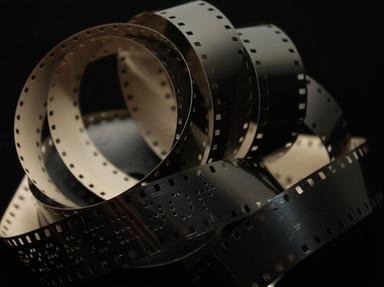Quiz Answer Key and Fun Facts
1. The development of special effects techniques in the second half of the 20th century culminated in movies such as "The Matrix" (1999). One of the innovations which contributed to the success of the "Matrix" trilogy, and was imitated immediately after by others, was the production of slow motion scenes, using multiple cameras and mixing live action.
However, simple slow motion has been known since 1904. It is achieved by projecting conventional 24 frames/second film at a lower frame rate, using an adjustable friction device.
2. Deep focus is a filming technique in which objects at different distances from the camera are in focus. It creates a perceptually more natural representation of space and gives equal importance to what happens at different planes of the scene.
The technique requires high-quality cameras and lighting and is well demonstrated in Bertolucci’s "Besieged" (1998). But to which resource could a director resort 60 years ago, in order to reproduce deep focus effects with only low-quality cameras at his disposal?
3. From its birth at the end of the 19th century, with the silent and one minute movies, until reaching its last developing state in the form of half-animated half-studio movies, cinema was mostly developed in the USA and diffused with time to other countries.
One excellent example was the post-World War II Japanese cinema which resulted in magnificent movies such as Kurosawa’s "Seven Samurai" (1954). The pre-war archaic cinema was modernized in the next two decades, with the introduction of which of the following techniques?
4. Westerns, usually describing fictional 19th century north-American life, had an important role in the history of Cinema. Interestingly, this style was strongly influenced by Italian movies produced in the 1960s and 1970s, known as Spaghetti Westerns, such as "A Fistful of Dollars" (1964). What characterized these movies in comparison to classic Westerns?
5. "Bonnie and Clyde" shocked the North American society in 1967 not only because it contained explicit violence, but mainly because it pioneered in showing, to the last detail, the physical consequences of the brutal action of the "heroes".
However, years before, Samurai movies dared to show their spectators realistic impressions of the fights. What type of realistic detailing was NOT used to create that impression?
6. The soundtrack of a movie frequently conforms to the image sequence, thus helping in setting the desired atmosphere. Sometimes it is used to create a continuity sensation in transitions between scenes, while being incongruous with the new scene images.
What is this type of sound technique called?
7. A scene atmosphere is frequently enhanced with the use of atmospheric conditions like a heat wave, rain, wind and storm. More sophisticated is the symbolic usage of weather elements to represent human feelings and thoughts, and even characters (personification).
Such exploitation of weather elements is a well-known Shakespearean motive. Appropriately, both Orson Welles' and Roman Polanski's "Macbeth" (1948 and 1971, respectively) opening scene is of terrifying heavy dark clouds. What is the generic term for this type of motif?
8. A fluent storytelling sensation in movies requires complete mastership of directing techniques. In one classic movie, the same chain of events is told by four different observers. The stories are so plausible, while completely diverging, that the movie's name is used now to refer to the subjectivity of perception on recollection. Can you name that movie?
9. "Star Wars" (1977) gave its viewers a strong storytelling experience, sometimes up to the sensation of reading a book. What technique did director George Lucas use frequently in order to create this feeling?
10. An ingenious way to tell an epic story, without losing the direct contact with the human element, is to tell the story not through the eyes of its heroes, but those of humble "secondary" characters who were dragged by destiny into the complex situations of the plot.
Which movie has such human element delivered by non-human actors?
Source: Author
zanazana
This quiz was reviewed by FunTrivia editor
skunkee before going online.
Any errors found in FunTrivia content are routinely corrected through our feedback system.
